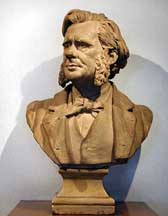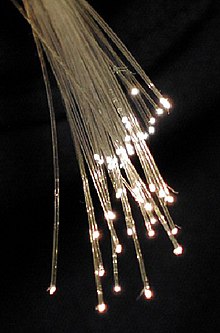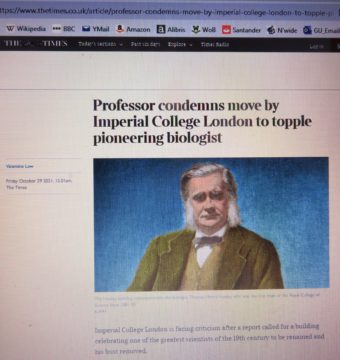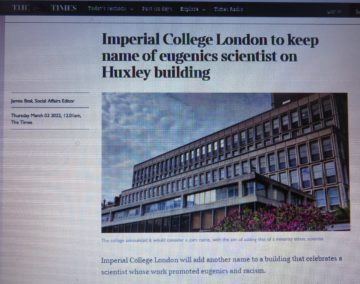by Paul Braterman

Disaster has been averted at Imperial. But much damage has been done, the group appointed to implement the decisions taken faces an impossible task, and the process has aggravated the very problem that it was meant to address.
For months, as I described here earlier, Imperial College has been contemplating the possibility of dis-honouring T. H. Huxley, one of its founders, on the basis of early remarks that we would now condemn as racist, but did no more than express the general assumptions of his time and place. This despite the fact that Huxley was a lifelong opponent of all forms of discrimination, a fierce opponent of slavery at a time when many cultivated Englishmen were sympathetic to the Confederate cause, and clearly changed his views about race over time.
 The President and the Provost have both been urging a whitewashing (if I can use this term) of the College’s history by such measures as removing Huxley’s name and bust from one of Imperial’s most prominent buildings. As I explained earlier, they attempted to accomplish this using a deeply flawed process. A History Group lacking in any higher level expertise in Huxley’s own areas of biology and palaeontology was set up, with the College archivist restricted to a consultative role, as was the Imperial faculty member best qualified to comment on historical matters. Two outside historians were consulted, but their areas of expertise did not really include Huxley.1 Adrian Desmond, Huxley’s biographer, was consulted but as I documented in my earlier article, his unambiguous vindication of Huxley was completely ignored. In October (revised version November), the History Group’s report recommended that Huxley’s name be removed from the Huxley Building, and his bust on display there relegated to a museum.
The President and the Provost have both been urging a whitewashing (if I can use this term) of the College’s history by such measures as removing Huxley’s name and bust from one of Imperial’s most prominent buildings. As I explained earlier, they attempted to accomplish this using a deeply flawed process. A History Group lacking in any higher level expertise in Huxley’s own areas of biology and palaeontology was set up, with the College archivist restricted to a consultative role, as was the Imperial faculty member best qualified to comment on historical matters. Two outside historians were consulted, but their areas of expertise did not really include Huxley.1 Adrian Desmond, Huxley’s biographer, was consulted but as I documented in my earlier article, his unambiguous vindication of Huxley was completely ignored. In October (revised version November), the History Group’s report recommended that Huxley’s name be removed from the Huxley Building, and his bust on display there relegated to a museum.
A request for comments on this report drew over 200 submissions. Despite earlier commitments, the Provost refused to publish these, alleging confidentiality, and instead a summary was prepared by two outside facilitators from Goldsmith College’s Department of Social, Therapeutic, and Community Studies, neither of them biologists nor historians. As might be predicted, this summary was obviously bad, suppressing all quantitative information about the general thrust of the submissions and giving equal weight to views that did, or did not, reflect historical reality. This summary was then made available to the President’s Board, a group of senior advisers to the President, with whom the final decision rested. Board members also had access to the full submissions, but as we now know these add up to around 90,000 words, and one wonders how many people at such a level of seniority could possibly have found time to read them all.
Fortunately, loud voices had been raised in protest both inside and outside Imperial, the tenor of a forum held to discuss the History Group report was unmistakable, and I know that at least some Board members were directly lobbied by academic staff opposed to the removal proposals. It may also be relevant that the President, a firm advocate of removal, is now in the last few months of her term of office, and has been further weakened by other controversies.
The board met on February 21, and an official account of its conclusions was published on February 25. According to this account, its main recommendations were as follows:

The Board committed to finding new ways to mark the impact and contributions of brilliant figures from underrepresented groups, having connections to Imperial, such as the Nobel Prize physicist Professor Abdus Salam , Dr Margaret Fishenden, who conducted seminal studies of combustion and heat transfer at Imperial , and Dr Narinder Singh Kapany, known as the father of fibre optics. This recommendation had met with widespread approval.
A working group has been established to implement these recommendations, and “To establish new ways for the Imperial community to continue to expose, engage with and learn from its history.”
The name and bust of TH Huxley will be retained, but put in context. This makes sense, provided the contextualising material comes from someone well informed about its subject matter. The submission to the History Group by Adrian Desmond, Huxley’s most noted biographer, would be a good start. The College will also consider a joint name for the building, linking Huxley to “a pathbreaking scientist from a Black, Asian or other minority ethnic background.”2 Here the working group faces a daunting challenge. There are very few scientists of any background whose names could be linked to Huxley’s without suffering by comparison, let alone if consideration is restricted to the underrepresented.
Similar recommendations made regarding commemoration of the Beit brothers, whose profits from mines in South Africa did much to finance the College, seem to me sensible although I have no expertise in this area. Specifically, the College will seek to direct its Beit scholarships to African scientists. Other de-naming recommendations seem to have been quietly dropped.
The Board also decided to release an anonymised version of the written submissions. This has the effect of showing the degree of distortion in the previously publicised summary. For example, the summary says that “Some participants felt such items [statues, busts, and historical artifacts] should be removed when possible as they are a daily reminder of enslavement and colonial legacy and not a reflection of the College current values.” In the full version, slavery (or slave, enslavement, etc.) is explicitly mentioned in 45 submissions. Two of these deal with a side-issue, the slave owner Sir Henry de la Beche. (Here the first version of the report was criticised for being too kind, but the matter had by then already been dealt with with at the Department level by removing his name from an award, renaming the geology society, and archiving his bust ) . Of the remaining 43, only 5 favour removing existing names or statues, 2 are ambiguous, and 36 are opposed to removal. 26 mention Huxley by name and all but twoof these oppose removal, with frequent mention of his enlightened attitudes and opposition to slavery. (It took me less than half an hour to establish all this, using simple word searching to scan the relevant submissions, which were generally quite unambiguous.)
Again, according to the summary,
Other [respondents] said they felt unwelcomed and rejected by Huxley’s links to eugenics, leading to feelings of marginalisation, disrespect, hurt and offence. Some that marking his legacy without this context had a negative effect on Imperial’s aspirations to equality and inclusion and its global standing.
This is flat out untrue.
By my count, 20 separate submissions mentioned eugenics. Of these, only one was in favour of renaming. 19 were opposed, and of these 18 mentioned Huxley by name, many pointing out that nothing in his writings could be said to support eugenics. As one respondent put it, capturing the general flavour of the responses, “taking down Huxley because his work contributed to eugenics is about as logical as cancelling Jesus because his name has been used to justify crusades.” Others also pointed out that to link Huxley to eugenics is unhistorical, since we can date the very term to Galton’s writing in 1883, some years after the work for which Huxley is chiefly remembered. (I would further add, since such charges are often raised by creationists against evolution science as a whole, that eugenics was deeply rooted in older beliefs2 about hereditary inferiority.
So how did the summary come to say what it did? Its authors, remember, were from Goldsmith College’s Department of Social, Therapeutic, and Community Studies, with no expertise either in history or in the relevant science. I must presume that, as non-experts, they wrongly imagined that the History Group spoke from a position of expertise, and allowed their perspective to be influenced accordingly. I emphasise this point because it helps explain the very real harm that this process has done to the College, and to the reputation of science in general.
Consider the History Group’s overall impact. To quote its own report,
The Group’s project was set up as part of a series of initiatives to address racial injustice. An important rationale for the project was to develop an understanding of how Imperial is perceived by a wide range of stakeholders, how this is influenced by its history (or perception of its history) and the extent to which this perception will hinder our ambition to establish a truly inclusive environment which allows all to flourish and to feel at home.
How well has the History Group succeeded in attaining these objectives? Not very. The recommendation to dis-honour Huxley achieved the rare distinction of being attacked both by the strongly Conservative Telegraph and the left-leaning Observer, sister paper to the Guardian. The Telegraph printed and re-echoed the letter of protest by 40 academics that the journal Nature had refused to publish. In the Observer , Kenan Malik, who himself studied at Imperial and is, for what it is worth, himself a member of a minority ethnic group, criticised the entire notion that real inequalities were being usefully addressed by such symbolic actions, while pouring scorn on a process that treated Huxley, an agent of scientific and social progress, in the same way as the slave trader Colston whose statue had been thrown into Bristol Harbour (or, I would add in the context of Imperial, the slave owner de la Beche discussed above). As Malik puts it,
Damning both equally as racists who do not deserve commemoration is to abandon historical evaluation for a crude mode of moral judgment.

The Times also gave sympathetic treatment to criticism of the history group report from within Imperial.
By the time the College’s decision was announced, Russia had invaded Ukraine, moving public attention away from this, as with so many other matters. The only newspaper accounts of the decision that I could find were in the Daily Mail online and, again, the Times.
The headline in the Daily Mail reads
Ethnic minority scientist’s name will be added to Imperial College building named in honour of Thomas Henry Huxley after claims that biologist who discovered birds were descended from dinosaurs was racist
Its bulleted summary states that the History Group had accused Huxley of ‘scientific racism’, while the full article reports academics’ rebuttal and praise of him as a role model.
The Times article, however, is extraordinary, not only restating the refuted claim that Huxley’s work had somehow led to eugenics, but describing him as a eugenicist himself.

Notice that this article appeared under the byline, not of a reporter, but of the Social Affairs editor. I can only surmise that it is playing a role in some wider agenda.
So, returning to the history group’s objectives, how will all this activity have affected “how Imperial is perceived” and the worthy “ambition to establish a truly inclusive environment which allows all to flourish and to feel at home”? Not, I fear, very well. The College has given us a shameful exhibition of poor scholarship, and besmeared the reputation of its founder. It created a false impression of impartiality and expertise in the setting up and naming of the History Group, thus enhancing the opprobrium it will attract from some for ignoring its recommendations. For those who, like the vast majority of historians, life science scholars, and respondents to the call for submissions, the accusations against Huxley were ill-informed and misguided, the exercise will leave them dismayed by the History Group’s recommendedations. For those, if there are any, who do really feel excluded and less able to flourish because of Huxley’s belief, in 1865, in a hierarchy of races, they will be dismayed that the Group’s central recommendation was not implemented, and will be feeling more excluded than ever. Who can blame them when the report itself and its Press coverage have given them so much cause?
One final irony. Within the UK at least, the biggest single cause of imbalances of power and education between groups is social class. Imperial itself is well aware of this problem, and includes this factor among others in its ambitious plans to widen access. What better role model, then, than a child forced by family poverty to leave school at age 10, who rose to the highest levels of accomplishment, whose scientific achievements continue to earn our admiration 150 years later, and who did more perhaps than any other person of his time to broaden educational opportunity? I give you

Thomas Henry Huxley
This article is an update of my earlier Intellectual Disgrace at Imperial College. As before, I thank numerous colleagues for discussions and relevant information, including Joe Felsenstein, Steve Hollenhorst, Nick Matzke, Andrew Petto, Betty Smokovitis, and members of Imperial’s academic staff. RCS Building image, Barabbas1312, CC BY-SA 4.0 <https://creativecommons.org/licenses/by-sa/4.0>, via Wikimedia Commons. Bust of Huxley, photograph George P. Landau, via https://victorianweb.org/victorian/religion/agnos.html . Huxley sketch by his daughter, Marian, via Wikipedia
***
1] To be fair, there was some overlap with the other main target for reconsideration, the Beit brothers, major donors towards the College, whose wealth derived from South African mines. Imperial College has no history department at such, but the academic staff member best qualified to pronounce on historical matters was also relegated to a consultative role.
2] Pet peeve: I wish people would not say “minority” when they clearly mean “underrepresented”. Albert Einstein came from a minority ethnic background, and as a result had to flee his country of birth, but I do not think that is what the College has in mind.
